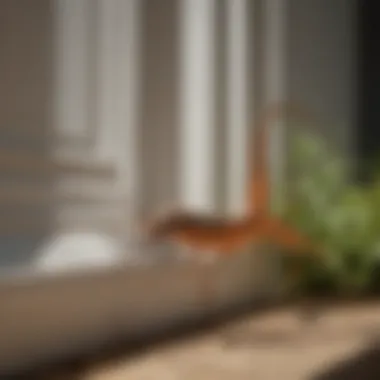Effective Strategies to Prevent Centipedes at Home


Intro
Centipedes often evoke a strong reaction in individuals. With their long bodies and numerous legs, they can trigger feelings of discomfort. While they do play a role in controlling other pest populations, many homeowners prefer to keep them outside. Understanding centipede behavior, identifying their entry points, and employing effective prevention strategies can all contribute to maintaining a pest-free home. In this article, we will explore the necessary steps to ensure that centipedes do not become unwelcome guests in your living space.
Pest Identification
Detailed Descriptions of Common Pests
Centipedes are distinctive arthropods. The most common species is the common house centipede (Scutigera coleoptrata). It is typically yellowish-brown with long, slender, and multisegmented bodies, measuring up to 4 inches in length. The house centipede is recognized for its ability to move rapidly and its numerous long legs—about 30 pairs. Moreover, outdoor species like the garden centipede can also infiltrate homes but are usually less common.
Signs and Symptoms of Infestations
Identifying a centipede infestation may require vigilance. Look for:
- Actual sightings of live centipedes, particularly in damp areas.
- Shed exoskeletons, which indicate growth.
- Droppings, resembling small black pepper grains, can also be a sign.
Centipedes thrive in humid environments, often hiding in dark, moist spaces such as basements or bathrooms.
Prevention Strategies
Home Maintenance Tips for Pest Prevention
Preventing centipedes from entering your home involves a comprehensive approach. Consider implementing the following strategies:
- Seal Cracks and Gaps: Inspect foundations, doors, and windows for any openings. Caulk or seal these areas tightly to eliminate possible entry points.
- Maintain Dry Conditions: Ensure proper drainage around your home. Utilize dehumidifiers in damp areas to minimize moisture, which attracts centipedes.
- Remove Clutter: Piles of debris, firewood, or other items around the home can provide hiding spots. Keeping clutter to a minimum can help deter centipedes.
Natural Deterrents and Barriers
Several natural methods can act as effective barriers against centipedes:
- Diatomaceous Earth: Sprinkling diatomaceous earth around entry points can deter centipedes, as it damages their exoskeleton.
- Essential Oils: Oils like peppermint or tea tree can repel centipedes. Mix a few drops with water and spray around entrances.
Treatment Options
Overview of Chemical vs. Natural Treatments
If prevention isn't sufficient and centipedes are already present, treatment options must be considered. Chemical solutions can be effective but also present environmental concerns. Natural treatments can be safer but may require more frequent application.
Step-by-Step Guides for DIY Treatments
For a DIY approach, follow these steps:
- Identify Entry Points: Check for cracks along baseboards, doors, and windows.
- Use Natural Deterrents: Apply diatomaceous earth around areas of concern. Allow it to sit for a few days.
- Monitor and Adjust: Observe for any reduction in centipede activity. If issues persist, consider using chemical pesticides specifically labeled for centipede control.
Implementing a combination of prevention and treatment methods can significantly reduce centipede presence in your home.
Following these strategies provides a more comfortable living environment, free from the disturbances that centipedes may cause.
Understanding Centipedes
Understanding centipedes is crucial for effective pest management in your home. By grasping their biology and behavior, you can create a proactive strategy to keep them outside where they belong. Centipedes are not just another insect; they play a role in our ecosystem, but their presence indoors can evoke unease and discomfort. Recognizing the importance of this topic allows homeowners to target specific methods to minimize encounters with these creatures.
What Are Centipedes?
Centipedes belong to the class Chilopoda and are typically elongated with numerous body segments, each housing a pair of legs. The common house centipede, scientifically known as Scutigera coleoptrata, is recognizable by its long, thin body and fast movements. These arthropods are nocturnal predators, feeding on insects and small insects, which is beneficial for pest control but can also lead them to intrude into living spaces in search of food and shelter. Their unique biology allows them to navigate various environments effectively, making it necessary to understand what they are and what attracts them to your home.
Life Cycle of Centipedes
Centipedes have a simple life cycle comprising egg, juvenile, and adult stages. Females lay eggs in moist soil or hidden locations, often resulting in hatchlings resembling miniature adults. The growth of centipedes occurs through molting, where they shed their exoskeleton multiple times as they mature into adults. In optimal conditions, centipedes can live up to several years, but the duration of each life stage varies based on temperature, humidity, and food availability. Understanding their life cycle is essential because it informs homeowners about the best times to take preventative actions against potential infestations.
Habitats Preferred by Centipedes


Centipedes are adaptable creatures, thriving in diverse habitats. They prefer environments that provide moisture, darkness, and adequate prey. Common locations indoors include basements, bathrooms, and kitchens, where damp conditions are prevalent. Outdoors, they often inhabit leaf litter, under rocks, and within mulch beds. Recognizing these preferences helps homeowners identify areas that might attract centipedes, leading to informed decisions about maintaining an environment that discourages them. By eliminating damp areas and clutter, it is possible to make your home less inviting to these pests.
Signs of Centipede Infestation
Identifying signs of centipede infestation is crucial for preventing larger problems down the line. Centipedes may seem relatively harmless, but their presence indicates that favorable conditions exist for them to thrive. Knowing the warning signs can help homeowners act swiftly to deter these pests before they establish a foothold in your living space.
Identifying Centipede Trails
Centipedes are nocturnal creatures and often leave trails that can be observed in low-light conditions. Look for faint lines on floors or walls, usually where there is little traffic. These trails may appear as light scratches or smudges. To effectively identify these trails, check corners, baseboards, and areas with little disturbance. If you notice these signs, it is a clarion call to inspect further and consider preventive measures.
Understanding Their Feeding Habits
Centipedes are predatory and feed primarily on smaller insects, such as spiders, cockroaches, and other soft-bodied bugs. They have a unique hunting style where they immobilize their prey using venomous bites. Understanding what attracts centipedes to your home can direct your preventive strategies. Reducing the availability of potential food sources like insects can deter centipedes from setting up residence. Regular cleaning and pest control measures can diminish their food supply.
Common Areas for Centipede Sightings
Certain areas of a home provide ideal habitats for centipedes. Dark, damp places often attract them. Common sites to watch for centipede activity include:
- Basements: Often humid, providing an acceptable living environment.
- Crawl Spaces: Typically overlooked spaces that may harbor moisture and potential prey.
- Bathrooms: These rooms frequently attract pests due to their damp conditions.
- Kitchens: An abundance of food can easily attract centipedes.
Understanding these common areas can help homeowners focus their monitoring and preventive efforts. Regular inspections in these spots can lead to early detection and more effective management of any potential infestations.
Entry Points Into Your Home
Understanding the entry points into your home is critical when seeking to keep centipedes at bay. Centipedes are notorious for finding their way indoors through small openings. They thrive in humid environments, which makes homes an attractive habitat for them. By identifying and sealing these points, homeowners can significantly reduce the chances of an infestation. Effective prevention requires a comprehensive approach that considers the various ways centipedes can enter.
Windows and Doors
Windows and doors are one of the most common ways centipedes enter homes. Poorly sealed areas around windows and doors can create easy access for these pests.
- Check for gaps: Examine the frames of all your windows and doors. Gaps can occur due to wear and tear or improper installation.
- Weather stripping: Install or replace weather stripping on doors and windows. This not only helps keep centipedes out but also improves energy efficiency.
- Screens: Use screens on windows, especially if they are frequently opened. Make sure screens are intact and have no tears.
It is important to remember that attention to detail can prevent small issues from becoming larger problems.
Cracks and Crevices in Walls
Cracks and crevices in walls provide additional entry points for centipedes. These openings can easily go unnoticed but can have a significant impact on pest management.
- Inspect thoroughly: Regularly check the walls, paying attention to areas that are less visible, such as near baseboards and behind furniture.
- Seal cracks: Use caulking or expandable foam to seal any noticeable gaps. Even small openings should not be ignored, as they can lead to bigger issues over time.
- Masonry sealing: For homes with brick or stone exteriors, consider applying a sealant to prevent centipedes from entering through small spaces.
Taking proactive steps to seal gaps will create a more formidable barrier against centipedes.
Basements and Crawl Spaces
Basements and crawl spaces often serve as ideal environments for centipedes due to their moisture levels. These areas can become breeding grounds if not maintained properly.
- Ventilation: Ensure that your basement and crawl spaces are well-ventilated. Poor air circulation can increase humidity, attracting centipedes.
- Moisture management: Consider using a dehumidifier to reduce humidity levels. This will not only discourage centipedes but also improve overall air quality.
- Insulation: If possible, insulate walls and ceilings in basements and crawl spaces. Insulation can help regulate temperature and prevent moisture accumulation.
Regular inspections of these areas are fundamental in maintaining a pest-free environment.
By focusing on these entry points, homeowners can significantly lessen the chances of centipedes invading their living space, helping ensure a more comfortable home.
Preventative Measures
Preventative measures are central to maintaining a centipede-free home. By creating barriers that deter these pests, homeowners can significantly reduce their chances of encountering centipedes inside. Effective prevention strategies focus on identifying potential vulnerabilities in your home environment. They largely include sealing entry points, employing physical barriers, and ensuring regular maintenance. Implementation of these strategies not only keeps centipedes away but also promotes a healthier, more comfortable living area.
Sealing Entry Points
Identifying and sealing entry points is a critical first step. Windows and doors should be checked for gaps or cracks. Using weather stripping can provide an effective solution for sealing these openings, ensuring that no space is left for centipedes to squeeze through. Additionally, inspect your foundation and exterior walls for cracks. If you find significant holes, consider using caulk or foam sealant to close them. Blocking off these entry points not only keeps out centipedes but also helps in preventing other pests from entering your home.
Using Screens and Shields
Screens serve as an effective physical barrier. Installing window screens and door screens can greatly reduce the risk of centipedes finding their way inside. Ensure that screens are tight-fitting and free from holes. You might also consider using bug shields or mesh barriers around vents and openings. This is especially beneficial for basements and attics, where ventilation is essential but can also become a gateway for pests. By using these screens and shields, homeowners can create an additional layer of defense against unwanted pests.


Regular Home Maintenance
Regular home maintenance cannot be overstated. It plays a vital role in keeping centipedes at bay. This means routinely checking for moisture build-up in basements, attics, and other damp areas, as centipedes thrive in such conditions. Keep your home dry by using dehumidifiers when necessary. Additionally, regularly cleaning your living spaces, particularly areas like kitchens and bathrooms, can deter centipedes because it removes their food sources. Keeping clutter to a minimum also helps, as centipedes often seek hiding spots in piles of debris or unorganized spaces.
It is essential to treat your home as a barrier. Regular checks and immediate repairs can prevent future infestations and ensure a comfortable living environment.
By focusing on these preventative measures, you can create a hostile environment for centipedes while simultaneously enhancing the comfort and safety of your home.
Natural Repellents
Natural repellents play a crucial role in managing centipede populations around your home. These methods rely on the use of readily available substances that deter centipedes without relying on harsh chemicals. Many homeowners prefer natural solutions as they are often safer for pets and children and less harmful to the environment. Moreover, these repellents can be more cost-effective, allowing for ongoing pest control without heavy financial investment.
Essential Oils as Deterrents
Essential oils possess properties that can naturally repel centipedes. Oils such as peppermint, tea tree, and clove are known for their strong scents, which these pests typically avoid. To create a natural repellent, mix a few drops of the chosen essential oil with water in a spray bottle. Spray this mixture around entry points and areas where centipedes are often seen. Regular reapplication is necessary, especially after rain or heavy cleaning. This method not only helps to keep centipedes away but also leaves behind a pleasant aroma in your living space.
Diatomaceous Earth Usage
Diatomaceous earth is a fine powder made from fossilized algal cells. This natural substance acts as a mechanical insecticide. It is safe for human use but deadly to many insects, including centipedes. When centipedes come into contact with diatomaceous earth, it damages their exoskeletons, leading to dehydration and death. To use this method, sprinkle diatomaceous earth in areas where you suspect centipede activity, such as near baseboards, windows, and basements. Ensure you apply a consistent layer and reapply it after cleaning or any exposure to moisture. This creates a barrier that reduces the likelihood of centipede presence.
Homemade Sprays for Prevention
Creating your own homemade spray can be an effective strategy against centipedes. Ingredients like vinegar, water, and dish soap can be combined to create a repellent solution. For instance, mixing equal parts of vinegar and water in a spray bottle can deter centipedes from entering your home. The strong scent of vinegar is particularly unappealing to these creatures. Another option is to combine water with a few teaspoons of dish soap, which can effectively eliminate centipedes on contact. Regularly using these homemade sprays around potential entry points reinforces your prevention efforts, maintaining a centipede-free environment.
"Using natural repellents fosters a safer home while effectively managing pest populations."
Overall, implementing these natural repellent methods will contribute significantly to your pest control strategy. Their effectiveness, safety profile, and ease of use make them suitable choices for homeowners seeking to enhance their efforts in keeping centipedes out.
Chemical Solutions
Chemical solutions can play a significant role in managing centipedes in your home. While proactive measures can help prevent their entry, sometimes a more direct approach is necessary. Understanding the types of insecticides available, their application, and safety is crucial for effective pest control.
Insecticides Designed for Centipedes
When considering chemical solutions, it is essential to choose insecticides specifically designed for centipedes. Common options include those containing pyrethroids, which are synthetic chemicals resembling natural insecticides. These products can effectively disrupt the nervous systems of centipedes, leading to their elimination. Available forms of these insecticides include sprays, granules, and even bait stations.
For effective usage, always read the instructions on the label. Key brands in the market include Ortho Home Defense and Raid Ant and Roach Killer. It is also important to apply these products in areas where centipedes are likely to hide, such as damp spots and cracks, enhancing the chances of contact with the insecticide.
Safety Guidelines for Chemical Use
Using pesticides safely is paramount. The first step is to wear protective gear like gloves and masks when applying insecticides. This ensures that you minimize skin contact and inhalation of potentially harmful chemicals.
- Read Labels Carefully: Always follow manufacturer instructions. Each product might have different guidelines for safe application.
- Ensure Proper Ventilation: Open windows and doors during application to reduce inhalation risks.
- Keep Pets and Children Away: Make sure that areas treated with insecticides are off-limits until they are completely dry or have been deemed safe by the label instructions.
"Safety should be your first concern when dealing with chemical solutions. Following guidelines helps prevent accidents and health risks."
When to Call Professionals
While home chemical treatments can be effective, there are times when it is wise to consult with pest control professionals. Consider reaching out for expert assistance in the following scenarios:
- If you observe a high number of centipedes or other pests, indicating a more significant issue.
- When attempts at self-treatment do not yield results. If insecticide applications fail to reduce propagation.
- If you have any doubts or concerns regarding the safe use of chemicals in your home environment.
Professional exterminators have access to stronger formulations and a better understanding of pest behavior. They also know the best application methods to ensure thorough treatment while prioritizing safety.
By considering these factors surrounding chemical solutions, you will be better equipped to decide on an effective pest management strategy against centipedes in your home.
Long-term Management Strategies
Long-term management strategies are crucial in achieving and maintaining a centipede-free home. Rather than focusing solely on immediate solutions, these strategies look at sustained prevention techniques. Utilizing long-term strategies reduces the likelihood of future infestations and creates an environment that is less attractive to centipedes.
Incorporating monitoring, consistent maintenance, and educational efforts into your pest management can enhance effectiveness. A thorough understanding of these aspects allows homeowners to take proactive measures that discourage centipedes from settling within their living space.


Monitoring and Regular Inspections
Insect populations can fluctuate, which is why monitoring and regular inspections are important. This means consistently checking areas that are prone to pest activity, such as basements, crawlspaces, and damp areas of the house. Look for signs of centipede presence, like shedding or trails.
Having a systematic approach can be beneficial. You can create a schedule to perform these inspections monthly or seasonally. Keeping a record of what you observe also helps in understanding trends and potential problem areas.
Regular monitoring will help you catch any incursion before it turns into a major problem.
Integrated Pest Management (IPM) Techniques
Integrated Pest Management is a holistic approach that combines various strategies to control centipede populations effectively. By understanding the life cycle and habits of centipedes, you can tailor the methods to fit your specific situation.
IPM techniques often include:
- Habitat Modification: Changing the environment to make it less appealing to centipedes. This involves reducing moisture and removing debris.
- Biological Control: Introducing natural predators can help keep centipede populations in check over time.
- Mechanical Methods: Setting traps and barriers can effectively reduce centipede access points without relying on chemicals.
Adopting IPM strategies ensures you address the root causes of infestations while using fewer chemicals, which is beneficial for both your family and the environment.
Educating Household Members
An informed household is an empowered household. Educating all residents about centipedes can lead to better prevention practices. Understanding what centipedes look like, where they frequent, and how they usually enter a home allows everyone to contribute to management efforts.
Household education can include:
- Identifying Entry Points: Teach members how to spot areas that might attract centipedes or serve as entrances.
- Discussing Cleaning Practices: Regular cleaning, particularly in areas like the kitchen and bathroom, can help reduce the chances of centipedes thriving.
- Promoting Timely Reporting: Encourage members to report sightings or problems. The sooner an issue is addressed, the easier it is to manage.
By fostering a culture of awareness and proactive measures among family members, you can significantly enhance your long-term management strategy against centipedes.
Additional Considerations
The issue of centipede management extends beyond standard practices of prevention and removal. Understanding these additional considerations is vital to developing a comprehensive strategy for maintaining a centipede-free environment in a household. This includes the impact of seasonal changes on centipede activity, potential allergic reactions that may arise from their presence, and the significance of recognizing local centipede species. Each of these points can influence how effectively one can prevent and control centipede infestations.
Seasonal Changes and Their Impact
Centipedes exhibit seasonal behavior that can affect their activities and movements. In warmer months, notably spring and summer, centipedes are often more active. They thrive in moist environments and seek shelter in warm areas within homes.
As temperatures drop in fall and winter, centipedes tend to seek warmer places indoors, which can increase the risk of infestations. People should be proactive during these seasons. Regular inspections at entry points, such as doors and windows, and maintaining dry conditions in basements can significantly reduce potential encounters with centipedes.
"Being aware of seasonal changes allows homeowners to mitigate risks effectively."
Potential Allergic Reactions to Centipedes
Though centipedes are not typically dangerous, their presence can lead to allergic reactions in some individuals. Symptoms may include itching, redness, or skin irritation upon contact. In severe cases, asthma or respiratory problems might arise, especially for those who are already allergic or sensitive.
It’s crucial to monitor household members for any adverse reactions and to address concerns immediately. If evidence suggests that centipedes are triggering allergies, consider employing preventive measures such as improving ventilation, reducing humidity, and using natural repellents on regular basis.
Understanding Local Centipede Species
Different regions host various species of centipedes, each having unique behaviors and habitats. Familiarizing oneself with local species helps in tailoring pest management strategies. In the United States, the common house centipede (Scutigera coleoptrata) is frequent in homes, recognizable by its long legs and swift movements. Meanwhile, the stone centipede often remains in outdoor areas, potentially entering households but less likely to establish itself indoors.
Knowing the characteristics of local species helps homeowners understand their habits and habitats. This knowledge affirms the importance of addressing specific entry points and adjusting prevention techniques accordingly. Identifying local species can also assist in determining the severity of an infestation.
By considering these elements, property owners can better prepare themselves in preventing and managing centipede encounters, ultimately leading to a more comfortable living space.
Closure
The conclusion is a critical part of the article as it emphasizes the significance of the strategies discussed for keeping centipedes from invading the home. Homeowners must remember that prevention is more effective than dealing with an infestation. By understanding centipede behavior and habits, individuals can take proactive measures that save time and resources in the long run.
Summary of Effective Strategies
To encapsulate the strategies outlined in this article, one can summarize key effective methods for centipede prevention. Homeowners should ensure that:
- Entry points are sealed: This includes windows, doors, cracks, and crevices.
- Regular maintenance is practiced: Routine cleaning helps eliminate potential hiding spots.
- Natural and chemical repellents are employed: Essential oils, diatomaceous earth, or insecticides can deter centipedes.
Implementing these strategies creates a layered defense, making it more difficult for these pests to enter.
Encouragement to Maintain Vigilance
It is vital for homeowners to remain vigilant in their efforts against centipedes. Regular inspections can help to catch early signs of an infestation. Furthermore, staying educated about local centipede species and their seasonal behaviors can also aid in prevention. This commitment to vigilance ensures a continuous pest management plan, optimizing one’s living space against unwanted visitors.



